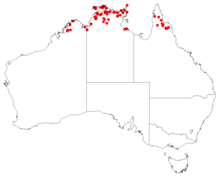Haemodorum brevicaule
Haemodorum brevicaule is a perennial herb from 0.025 to 0.3 m tall, in the bloodroot family, the Haemodoraceae,[2] native to northern Australia.[3] It has deep-red to purplish-black flowers[4] which are seen from September to December, and it grows on red clay and basalt.[2]
| Haemodorum brevicaule | |
|---|---|
| Scientific classification | |
| Kingdom: | Plantae |
| Clade: | Tracheophytes |
| Clade: | Angiosperms |
| Clade: | Monocots |
| Clade: | Commelinids |
| Order: | Commelinales |
| Family: | Haemodoraceae |
| Genus: | Haemodorum |
| Species: | H. brevicaule |
| Binomial name | |
| Haemodorum brevicaule | |
 | |
| H. brevicaule Collection data from Australasian Virtual Herbarium | |
Etymology
The name, Haemodorum, was chosen by Smith in 1798[5] for the blood-red root, haem- being Greek for blood-red.[6] Mueller[1] in 1858, gave this species the specific epithet, brevicaule, which derives from the Latin brevi- (short)[7], and caulis (stem)[8], giving the meaning 'short-stemmed'.
Description
It has flat, hairless, leaves about 9 to 31 cm long and 0.5 to 2 mm wide, and a smooth scape about 9 cm to 13 cm long. The perianth is formed of two rings of three tepals which are uniformly red, red-brown, purple or black.[2] It has three stamens all at the same level with the filaments being 1 to 1.2 mm long and having slightly longer anthers. The plant flowers from September to December.[2]
Distribution
It is found in Western Australia, the Northern Territory and Queensland in the IBRA regions of the Northern Kimberley,Victoria Bonaparte,[2] Arnhem Coast, Darwin Coastal, Northern Kimberley, Pine Creek, Central Arnhem, Tiwi Cobourg, Arnhem Plateau, Gulf Coastal, Daly Basin, the Cape York Peninsula region[9] in open eucalypt forest in dry sandy soils, and also in places that are seasonally flooded.[4]
Taxonomy
H. brevicaule was first described by Ferdinand von Mueller in 1858.[1] This description was slightly modified in 1987 by Macfarlane.[10][11] The syntype is held in the National Herbarium of Victoria and was collected by Mueller in 1855 towards the Macadam range in the Victoria-Daly region of the Northern Territory.[12]
References
- von Mueller, F.J.H. 1858. "Fragmenta Phytographiae Australiae 1(3): 64". Retrieved 4 May 2018.
- "Haemodorum brevicaule". FloraBase. Western Australian Government Department of Parks and Wildlife.
- "Australia's Virtual Herbarium: Haemodorum brevicaule". Retrieved 1 May 2018.
- Macfarlane, T.D. 1987. "Flora of Australia Online: Haemodorum brevicaule, Data derived from Flora of Australia Volume 45 (1987), a product of ABRS, ©Commonwealth of Australia". Retrieved 4 May 2018.
- Smith, James Edward. 1798. Transactions of the Linnean Society of London 4: 213-214 in Latin
- Stearn, W.T. 1992. 'Botanical Latin : history, grammar, syntax, terminology and vocabulary.' (p.423) (Portland, Oregon: Timber Press)
- Stearn, W.T. 1992. 'Botanical Latin : history, grammar, syntax, terminology and vocabulary.' (p.378) (Portland, Oregon: Timber Press)
- Stearn, W.T. 1992. 'Botanical Latin : history, grammar, syntax, terminology and vocabulary.' (p.503) (Portland, Oregon: Timber Press)
- "AVH: Haemodorum brevicaule (mapview - left panel: IBRA 7 regions), Australasian Virtual Herbarium". Retrieved 4 May 2018.
- "APNI: Haemodorum brevicaule, Australian Plant Name Index". Retrieved 4 May 2018.
- Macfarlane, T.D. 1987. in A.S.George (ed.) Haemodorum Flora of Australia 45
- "Syntype: Occurrence record: MEL 0103528A, Australasian Virtual Herbarium". Retrieved 4 May 2018.